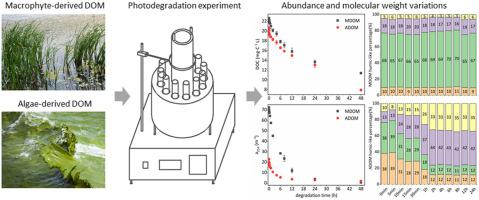Chemosphere ( IF 8.1 ) Pub Date : 2021-05-03 , DOI: 10.1016/j.chemosphere.2021.130633 Xiaowei Fu 1 , Haiyan Du 2 , Huacheng Xu 2

|
Dissolved organic matter (DOM) is ubiquitous in aquatic environments, whose behaviors and fate are highly related to the chemical compositions and size distribution. In this study, the UV-induced photodegradation properties of DOMs with different origins (i.e., macrophyte- and algae-derived) were investigated using absorption and fluorescence spectroscopy as well as flow field-flow fractionation (FlFFF). Results showed that, irrespective of DOM origins, the chromophoric components could be more effectively photo-degraded than the non-chromophoric ones. Though the two DOMs were characterized with similar fluorophores, the photodegradation properties showed obvious heterogeneities in DOM origins and molecular weights (MWs). Compared to macrophyte-derived DOM (MDOM), the algae-derived DOM (ADOM) exhibited a higher degradation rate and efficiency due to the abundance of labile components like newborn protein-like substances. The FlFFF results revealed a high photo-preferability of 100 kDa-0.45 μm protein-like MDOM and same photo-sensitivity of the size-fractionated humic-like moieties, testifying the reduction of molecular sizes during the photodegradation. However, the increase in relative percentage for 100 kDa-0.45 μm protein-like components and 5–15 kDa humic-like moieties implied a possible enhancement of molecular sizes for ADOM during the early period (i.e., the first hour) of photodegradation. This study provides new insights into the origin-related heterogeneities in compositions and size distribution for DOM transformation.
中文翻译:

不同来源的溶解性有机物在紫外线诱导下的光降解特性比较
溶解有机物(DOM)在水生环境中无处不在,其行为和命运与化学成分和尺寸分布高度相关。在这项研究中,使用吸收光谱和荧光光谱以及流场-流分馏法(FlFFF),研究了紫外线诱导的具有不同来源(即源自大型植物和藻类)的DOM的光降解特性。结果表明,与DOM的来源无关,发色成分比非发色成分更有效地被光降解。尽管两个DOM具有相似的荧光团特征,但光降解特性在DOM的起源和分子量(MWs)上显示出明显的异质性。与源自大型植物的DOM(MDOM)相比,藻类来源的DOM(ADOM)由于诸如新生儿蛋白质样物质之类的不稳定成分的丰富而表现出更高的降解率和效率。FlFFF结果显示了100 kDa-0.45μm的蛋白样MDOM具有较高的光优先性,并且大小分级的腐殖质样部分具有相同的光敏性,证明了光降解过程中分子大小的减小。但是,100 kDa-0.45μm的蛋白质样成分和5-15 kDa的腐殖质样部分的相对百分比增加,表明光降解的早期(即第一个小时)ADOM的分子大小可能会增加。这项研究提供了有关DOM转换的成分和大小分布中与起源相关的异质性的新见解。FlFFF结果显示了100 kDa-0.45μm的蛋白样MDOM具有较高的光优先性,并且大小分级的腐殖质样部分具有相同的光敏性,证明了光降解过程中分子大小的减小。但是,100 kDa-0.45μm的蛋白质样成分和5-15 kDa的腐殖质样部分的相对百分比增加,表明光降解的早期(即第一个小时)ADOM的分子大小可能会增加。这项研究提供了有关DOM转换的成分和大小分布中与起源相关的异质性的新见解。FlFFF结果显示了100 kDa-0.45μm的蛋白样MDOM具有较高的光优先性,并且大小分级的腐殖质样部分具有相同的光敏性,证明了光降解过程中分子大小的减小。但是,100 kDa-0.45μm的蛋白质样成分和5-15 kDa的腐殖质样部分的相对百分比增加,表明光降解的早期(即第一个小时)ADOM的分子大小可能会增加。这项研究提供了有关DOM转换的成分和大小分布中与起源相关的异质性的新见解。但是,100 kDa-0.45μm的蛋白质样成分和5-15 kDa的腐殖质样部分的相对百分比增加,表明光降解的早期(即第一个小时)ADOM的分子大小可能会增加。这项研究提供了有关DOM转换的成分和大小分布中与起源相关的异质性的新见解。但是,100 kDa-0.45μm的蛋白质样成分和5-15 kDa的腐殖质样部分的相对百分比增加,表明光降解的早期(即第一个小时)ADOM的分子大小可能会增加。这项研究提供了有关DOM转换的成分和大小分布中与起源相关的异质性的新见解。











































 京公网安备 11010802027423号
京公网安备 11010802027423号